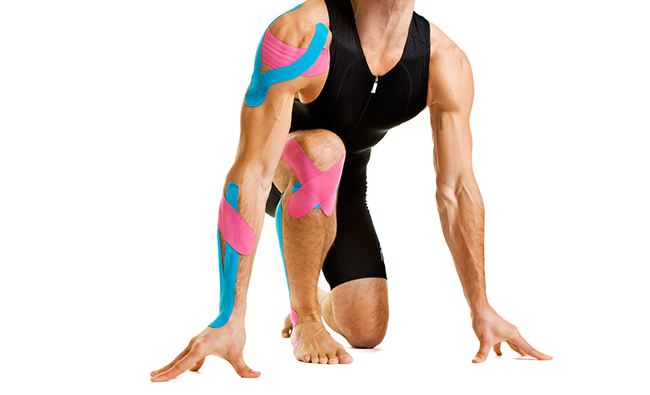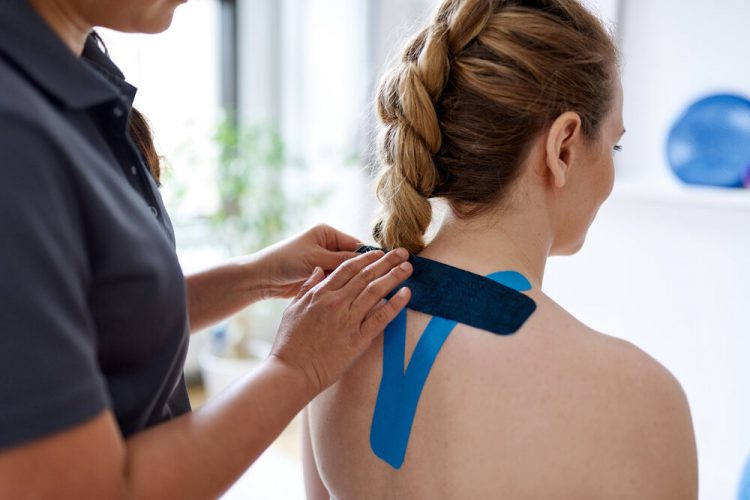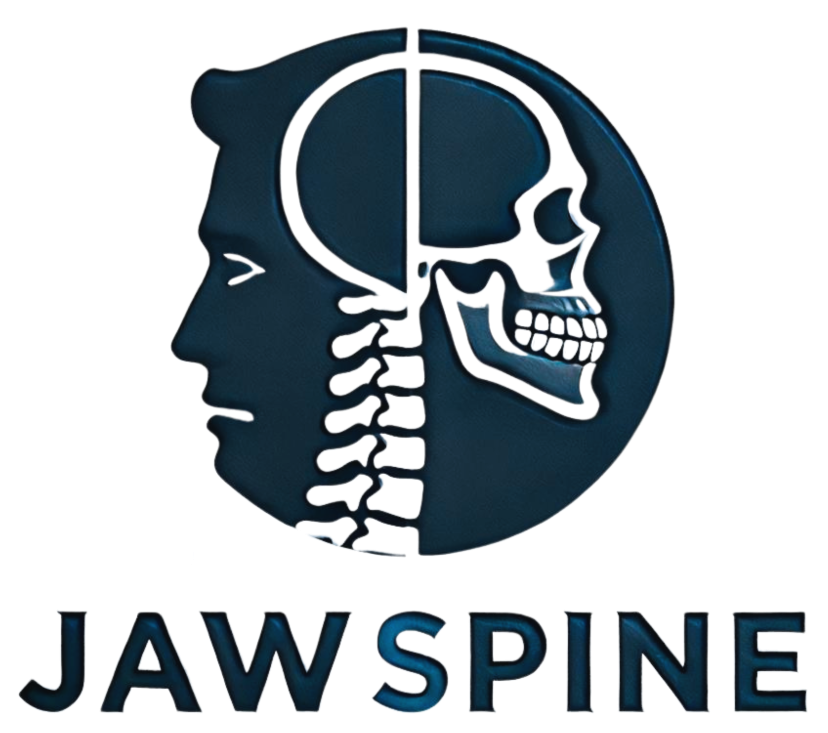Jaw & Spine Kinesio-Taping Therapy: Enhance Recovery & Relieve Pain

What is Kinesio-Taping?
Taping is a therapeutic technique used to support and stabilize muscles and joints without restricting your range of motion. By applying adhesive tape to specific areas of the body, taping helps prevent injuries, reduce pain, and enhance the body’s natural healing processes. Taping is commonly used in sports medicine, rehabilitation, and chiropractic care to treat various musculoskeletal conditions.
How Does kinesio-taping Work?
Taping is based on the body’s natural healing processes and the biomechanics of movement. Here’s how it works:

Improved Circulation and Lymphatic Drainage
By gently lifting the skin, taping helps to create space between the skin and the underlying tissues. This allows for improved blood flow and lymphatic drainage, reducing inflammation and swelling.

Enhanced Muscle Function
Tape can be applied in different ways to either support weak muscles or relax overactive ones. This helps restore balance to the musculoskeletal system and enhances overall muscle function.

Pain Relief
The tape’s unique properties allow it to provide proprioceptive feedback to the brain, which can help reduce the sensation of pain. Additionally, the improved circulation and reduced inflammation also contribute to pain relief.

Support Without Restriction
Unlike rigid tapes, tape moves with your body, providing support without limiting your range of motion. This makes it an ideal option for athletes and active individuals who need both stability and flexibility.

Benefits of Taping in Chiropractic Care
Taping is a valuable tool in chiropractic care, offering a range of benefits that complement other treatments such as adjustments, soft tissue therapy, and exercise rehabilitation. Here are some of the key benefits:
- Injury Prevention: Taping can be used to stabilize joints and muscles, reducing the risk of injury during physical activity. This is particularly beneficial for athletes and those with a history of musculoskeletal injuries.
- Pain Management: Both traditional taping and taping can help alleviate pain by providing support to injured or overused muscles and joints. Taping, in particular, offers a gentle and non-invasive way to reduce pain and inflammation.
- Enhanced Healing: By improving circulation and lymphatic drainage, taping helps to accelerate the body’s natural healing processes. This can lead to faster recovery times for injuries such as sprains, strains, and muscle tears.
- Improved Posture and Alignment: Taping can be used to correct poor posture and alignment, which can reduce strain on muscles and joints. Over time, this can lead to improved function and reduced pain.
- Support for Chronic Conditions: Taping and taping can be effective for managing chronic conditions such as arthritis, tendonitis, and plantar fasciitis. By providing ongoing support, these techniques can help manage symptoms and improve quality of life.
Conditions Treated with Taping
Taping can be used to treat a variety of conditions, including:
- Sprains and strains
- Muscle imbalances
- Tendonitis
- Plantar fasciitis
- Shin splints
- Knee pain (e.g., patellofemoral pain syndrome)
- Shoulder injuries (e.g., rotator cuff injuries)
- Low back pain
- Postural imbalances
- Carpal tunnel syndrome
- Lymphatic issues (e.g., lymphedema)

FAQ
During a taping session, the chiropractor will assess your condition and determine the best taping method for your needs. The tape is then applied to the affected area in a specific pattern designed to provide optimal support and therapeutic benefits. The process is quick and painless, and the tape can be worn for several days, even during physical activity and showers.
Taping is typically applied with minimal tension to allow for full range of motion, while traditional taping may be applied more tightly for increased stability. After the tape is applied, you may notice immediate relief from pain and improved function. The tape is usually replaced every few days, depending on your activity level and the nature of your condition.
Taping and taping offer a versatile and effective way to manage pain, support healing, and improve performance. Whether you’re recovering from an injury, managing a chronic condition, or looking to prevent future issues, these techniques can be a valuable part of your overall care plan. Their non-invasive nature and ability to support natural movement make them suitable for a wide range of patients, from athletes to those with chronic pain.
26 Wellington St E, Unit 110, Toronto, ON M5E 1S2, Canada
Hours
Friday: 9 am – 5 pm
Saturday: 10 am – 4 pm
Sunday: Closed
Direct Billing Available in Toronto
Belleville
Belleville Quinte Chiropractic & Sports Injury Clinic
65 Dundas St E. Belleville ON K8N 1B9
Hours
Mon & Tue: 8:30 am – 2:30 pm
Wednesday: 8:30 am – 6 pm
Thursday: 2:30 pm – 6 pm
Direct Billing Available in Bellevile
Picton
County Chiropractic Centre
49 Main Street, Picton, ON K0K 2T0
Hours
Tuesday: 3 pm – 6 pm
Thursday: 9 am – 2 pm
Wellington
County Chiropractic Centre
296 Wellington Main St, Wellington, ON K0K 3L0
Hours
Monday: 3 pm – 6 pm
Working Hours
- Monday: 8:30 am – 2:30 pm (Belleville) | 3 pm – 6 pm (Wellington)
- Tuesday: 8:30 am – 2:30 pm (Belleville) | 3 pm – 6 pm (Picton)
- Wednesday: 8:30 am – 6 pm (Belleville)
- Thursday: 9 am – 2 pm (Picton) | 2:30 pm – 6 pm (Belleville)
- Friday: 9 am – 5 pm (Toronto)
- Saturday: 10 am – 3 pm (Toronto)
Our Popular Services
At Jaw & Spine Chiropractic Centre, we are committed to providing comprehensive chiropractic care tailored to the unique needs of each patient. Our clinics specialize in the treatment of all neuromusculoskeletal disorders, with a particular focus on managing jaw and orofacial pain.
Quick Contacts
- Copyright 2025 The Jaw & Spine Doctor
